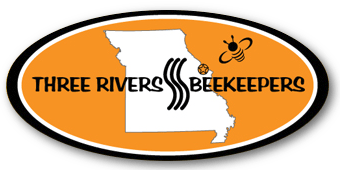This document was written for new beekeepers with ten or fewer hives.
Many years ago, small beekeepers would cut the comb from the frames and would crush the comb by squeezing it. This method of extraction required the bees to rebuild the comb each season which takes a lot of effort. Today, beekeepers try to do minimal damage to the comb during the extraction process. This helps the bees produce more honey. Some say it takes about the same amount of effort to draw the comb as it does for the bees to fill the super with honey. If care is taken to minimize damage to the comb during extraction, the drawn honey super comb will last for years.
The first step in preparing for the extraction process is to remove the bees from the honey super. This can be accomplished by multiple methods. One can use a bee escape placed over the hole in an inner cover and leave it in place overnight. Another method is to use a fume board treated with Bee Go. This works best when temperatures are hot and sun hits the hive. Some beekeepers use a bee brush and brush the bees off each frame. This method requires you to have a spare empty super and cover to keep the bees out while brushing the next frame. I tend to prefer a leaf blower to remove the bees. Turn the super on its end on top of the hive with the bottom of frames facing you. Use the leaf blower to remove the bees. Just don’t blow the bees out so they hit anything. You don’t want to harm your bees. Yes, some bees will land in the grass in front of the hive but they will return to the hive in a few minutes.
The extraction process starts with removing the cell caps from the frames of honey. You will need some basic tools to remove the caps. First, you need an uncapping knife. This can be any long, flexible sharp knife. A serrated bread knife or a 9 inch fillet knife works fine. You will also need an uncapping pan. I use a stainless steel sheet cake pan. A board across the top of the pan with a nail or sharp screw sticking up will allow you to place the frame of honey on it and rotate it easily to uncap both sides of the frame. A Cappings Scratcher is needed to remove the caps on cells that you cannot uncap with the knife. A Cappings Scratcher can be used to remove all the caps in place of a knife but that would be a slow process.
Once the caps are all removed, the frame is ready for honey extraction. Honey extractors come in several types and they are not cheap. A two frame hand cranked extractor is sufficient for the small scale beekeeper managing less than ten hives. Three Rivers Beekeepers Club has two hand cranked tangential extractors that a club member can borrow. In tangential extractors, the honey frame sits perpendicular to the axis of the extractor basket. With tangential extractors, it extracts the honey from one side of the honey frame at a time. One must manually reverse the honey frame to extract the opposite side. When you start cranking the full honey frames don’t spin too hard on the first side or you could crack the foundation because of the weight of honey in the other half of the frame. After you rotate the frame start slow and speed up as honey is extracted. I again rotate the frame and spin it fast on the first side extracted. This gets most of the honey out of the comb. The type of extractor is what limits the number of hives that is practical to extract.
In radial extractors, the honey frame sits parallel to the axis of the frame holders. You don’t have to rotate the frames as both sides are extracted at the same time. To get all the honey out and not damage the comb, some beekeepers will start rotating the basket slow and then speed up once most of the honey is out of the comb. Also, most radial extractors are motor driven and are even more expensive.
Once you have extracted a few frames, the honey will start hitting the bottom of the rotating basket and this makes it difficult to spin the basket. It is then time to open the gate on the extractor and drain the honey into a storage bucket. I have one bucket dedicated to straining the honey as it comes out of the extractor. This bucket sits on top of the honey storage bucket. To strain the honey for bees parts, wax, and other debris, I use a washed 5 gallon cloth paint strainer in the top bucket.
I do strain the honey again with a 200, 400, or 600 micron filter on top of the bottling bucket which will pick up any wax that may have gotten through the paint strainer. Once the honey has filled the bottling bucket, allow about 3 days for all the air bubbles to rise to the surface of the honey. If you have too many bubbles in the honey, it can make the bottled honey look like it has foam on top.
If you want to see a demonstration of honey extraction, you can take a look at the following:
https://www.youtube.com/watch?v=KK1VL6w9CeA (Comments – You can skip the advertisement. This film demonstrates using an uncapping roller instead of a knife to remove the caps so the honey can be extracted. I have not recommended this type of uncapping method as I have not tried it and don’t know how much this method damages the comb. Also, this clip may not represent best management practices when it comes to managing the hive.)
Joe Copeland
Posted June 6, 2020
